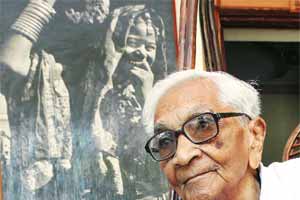At 104,countless memories in black and white
Pranlal Patel looks back on a lifetime of achievement before photography went digital

Among various memories from across his 104 years,Pranlal Patel likes to talk about an argument he had with a school inspector that led to his resignation as a primary teacher. And about painting lessons he took from artist Ravishankar Rawal before he gave that up,too,preferring to take up the camera instead.
I wanted more excitement than my 11-to-4 job as a schoolteacher could provide, says Patel,who last week was given a lifetime achievement award at the National Photo Awards.
monthly limit of free stories.
with an Express account.
I started out as an outdoor photographer in 1933,with funds from friends,self-taught at a time when photographers were a rarity, Patel,born 1910,says at his Ahmedabad home. I would cycle across Ahmedabad with my box camera,sending my photographs to dailies in Mumbai,Delhi,Kolkata,Chennai. I started being paid handsomely by editors,who would fill pages with my pictures.
He belongs strictly to the old school. He stresses the virtues of black and white,and is so uncomfortable with the digital age that he gave up professional photography in 2000.
I like to click people and history is important to me, he says. I got great joy from not knowing which of my photographs would make it to the papers. I would dwell on the subject,make notes of events. Photojournalism today has become easier,but has left no scope for my kind of photography to flourish. That is why he gave it up,says his son,Anand Patel.
His frames from across so many decades include varied themes of a monkey sitting on a horse,a sadhu on a bed of nails,labourers at work or on the riverbed,spiritual processions and Ahmedabad. Some of his later works include photos of the 12 Darwazas,political leaders,the Sabarmati riverfront,Kashmir,tribals and pastoral life.
He also married a photographer,the late film editor Damayanti Patel. Son Anand has picked up the art,and says every day helping his father was a lesson.
Among Patels anecdotes are some from the freedom movement. I used to click pictures for the British government and secretly work for the freedom movement too,using aliases, he says. Two photographs that come to mind are of freedom fighter Jaymal Jayantilal Thakore escaping the British disguised as a Rabari in 1942,and Jawaharlal Nehru and Sardar Patels hurried meeting with women leaders on the Bhadrakali compound in 1937. He missed Mahatma Gandhis departure from the city,but later clicked the horse-cart carrying Gandhis ashes near Dilli Darwaza in 1948.
With his studio on Ashram Road,Patel was sought after by newspapers,textile mill owners,and erstwhile royals through the 1950s and 60s. Anand recounts an incident from 1949. Manohar Sinh Jadeja,the then Maharaja of Rajkot,had wanted his wedding filmed. In those days,there were no other takers for such a project with a moving camera. When he contacted Patel,the latter sought a truck and a lot of equipment. His work won him a friendship with the maharaja.
Honours Patel has won include the Kodak Limited Award for photographic excellence in 1963-64,and the Fuji Film Prize in 1979 organised by Unesco. Hilton University in the US plans to host next January an exhibition of his work on the first womens organisation of Ahmedabad,Jyoti Sangh,and its role in mobilising women for the freedom movement.
My father has preserved his work very well,which is the reason his work has been well appreciated, says Anand Patel.
Patels favorite photograph is that of a man casting a fishing net into the Chandola lake. A colour photograph hands you all the information. One uses the mind more to gauge a black-and-white one, he says. Digital photography today restricts your thought process,so I have never worked with digital cameras. When I was taking a picture,I would know exactly how it would come out.
Yet he is delighted that his family has taken to digital photography. Every member is working in either museum photography,medical documentation or wedding photography.